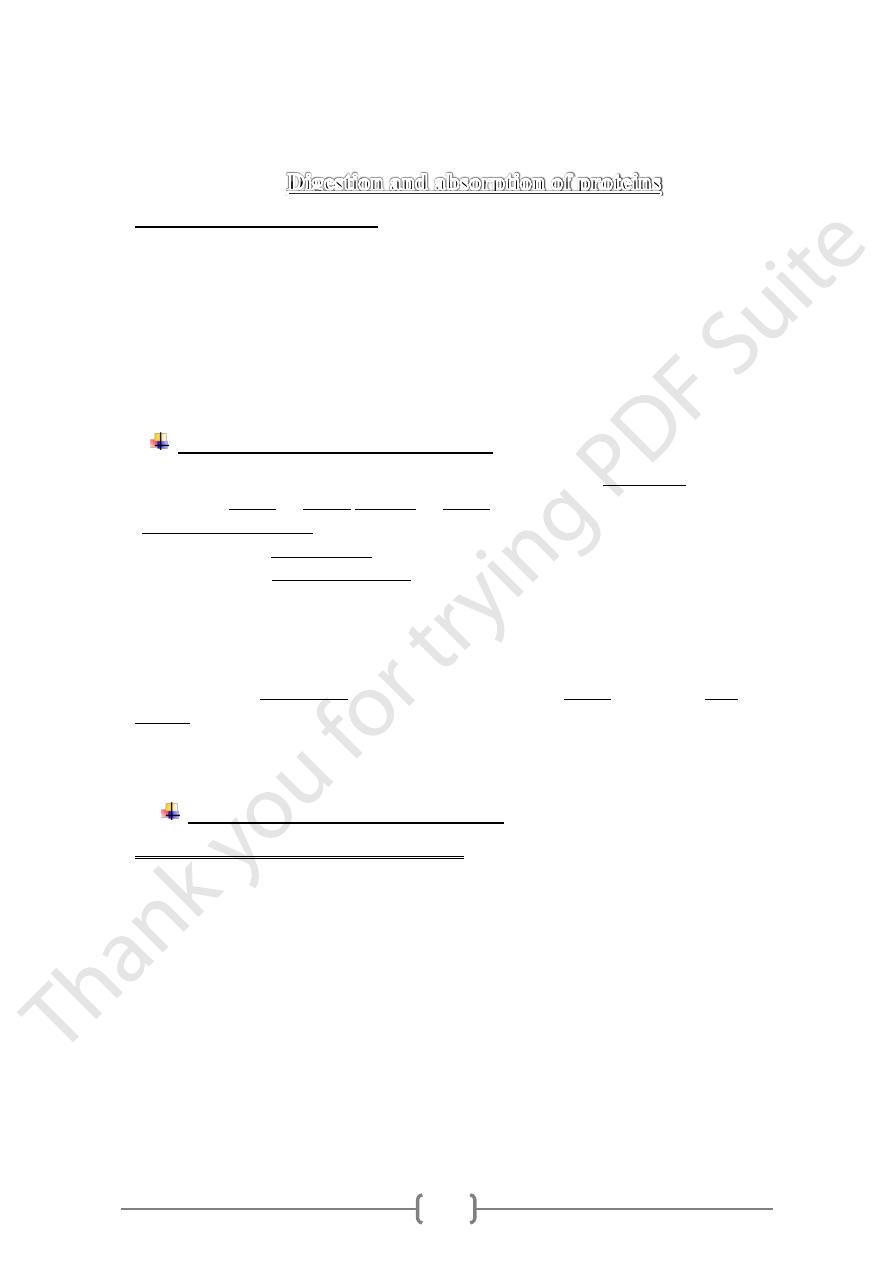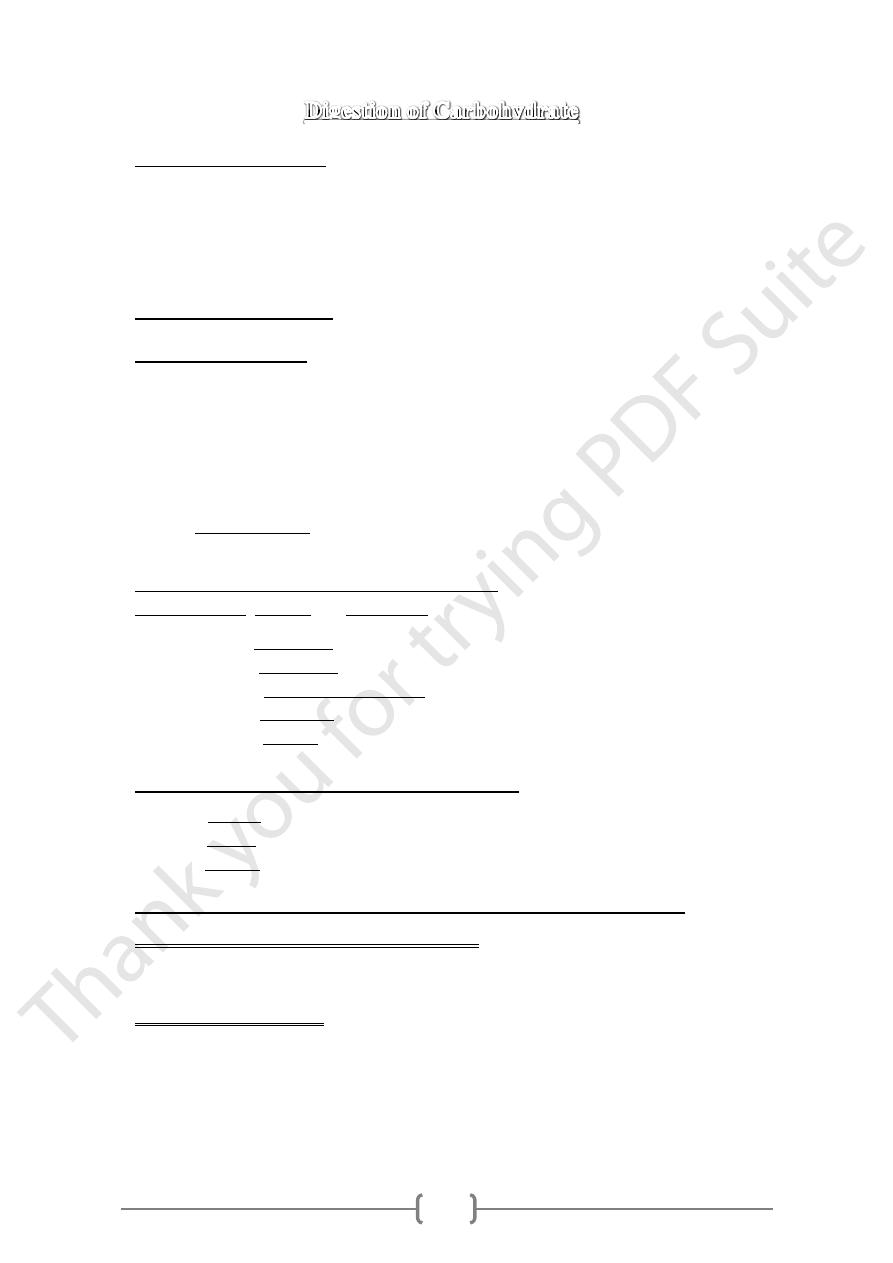
12
Lec. 4 Digestion of Proteins & Carbohydrates
General aspects of proteins
1) Proteins are a complex structured material composed of a different numbers of amino
acids. (polypeptide, oligopeptide and dipeptide)
2) Proteins in the diet should be hydrolyzed to their amino acids before their absorption.
3) Sometimes amino acids as such are found in minor quantities in natural food stuffs.
4) About 10-30 grams of proteins present in various digestive juice.
5) Another 10 grams of proteins comes from cell desquamation.
6) Less than 10% of total proteins are not absorbed.
A- Protein digestion in the stomach
1) Protein digestion begins by the action of pepsin. The proenzyme pepsinogen is
converted to pepsin by gastric HCl and by pepsin itself. The last process is called
"autocatalytic activation",
2) Pepsin hydrolyzes native protein "milk proteins",
Or the protein partially denatured by the low “PH”
Or protein denatured by cooked food.
3) The action and conversion of the enzyme pepsin depends on gastric HCl production.
If gastric HCl fails to maintain gastric PH at 2-3: Then protein digestion may be very
limited.
4) The liberation of amino acids form protein by the action of pepsin is relatively slow
process.
5) Protein chiefly converted to: poly peptides rather than to amino acids: this is because:
food remains in the stomach for a limited time.
B- Protein digestion in the intestine
1
st
Activation of pancreatic proenzymes
1) The pancreatic alkaline fluid contains inactive precursors of several proteolytic
enzymes.
2) These precursors are changed to their active form by the action of Enteropeptidase
an enzyme in the intestinal mucosa which specifically and rapidly converts
trypsinogen to trypsin.
3) The action of enteropeptidase is essential. Since trypsin is responsible for the
conversion of all other inactive proenzymes to their active form.

13
2
nd
specific enzyme activities of pancreas
1) The alkaline pancreatic juice: neutralizes the acidic fluids from the stomach.
2) Endopeptidases: Trypsin, Chymotrypsin and Elastase cleave peptides in their centers
more than from their ends.
3) Exopeptidase: carboxypeptidase A and B: cleave peptides at their ends more than
from their centers.
A. Carboxypeptidase –A: rapidly liberates carboxyl group of amino acids that
possess aromatic or aliphatic side chain.
B. Carboxypeptidase –B: acts only one peptides with terminal arginine or lysine
residues.
3
rd
specific enzyme activities of intestinal mucosA
1) These enzymes may be secreted into the intestinal juice but their main action is
intracellular.
2) Hydrolysis of oligopeptides may take place after their entry into the mucosal cells or
during transport across the epithelial cells.
Absorption of amino acids and oligopeptides
A. Active transport against the concentration gradients
1) Neutral amino acid transport system: active transport of mono amine and mono
carboxyl amino acids such as: alanine, glycine and valine.
2) Dibasic or diamino amino acids: lysine, arginine and cystin.
3) Dicarboxylic or acidic amino acids: glutamine and aspartate.
4) Imino acids: Glycine and proline.
B. Other routes of amino acids transport
5) Amino acids can also transport across the intestinal mucosal cells by two distinct
path ways:
i. Active transport of di- and tri- peptides :
ii. Carrier mediated transport : for the larger peptidase :
Then all the absorbed AA in the mucosal cells diffuse into the portal blood
and then travel to the liver.
6) Some proteins enter the blood stream directly such as thyrotrophine releasing
hormone which is resistant to amino and carboxy peptidases.
7) Some native proteins also penetrate the intestinal mucosa by a process of: non
selective pino-cytosis and appears in the blood directly. This is enhanced by the
presence of potent trypsin inhibitor factors such as that found in milk and eggs
and may lead to allergic manifestations in child feeding milk.

14
A. Digestible carbohydrate:
1) Starch : composed of amylose and mylopectine
2) Glycogen: composed of glucose.
3) Oligosaccharides: are chains contain less than12 sugar bases.
4) Disaccharides: composed of only two molecules. (lactose).
5) Monosaccharides: composed of only on molecule. (glucose).
B. Indigestible carbohydrate: cellulose, xylans, pectins.
Digestion of Starch
1) Starch is hydrolyzed to disaccharides and oligosaccharides by salivary and pancreatic
α-amylase.
2) Then to monosaccharides by enzymes of the brush border membrane.
3) Major locus of starch and glycogen digestion is in the small intestine (pancreatic α-
amylase) which acts in the hydrolysis of the α 1,4 linkage between monosaccharides.
o Starch α-amylase amylose + amylopectine.
o Amylopectine : contains α- 1,6 linkage and α- 1,4 linkage.
But α-amylase cannot hydrolyze the α-1,6 linkage thus resulting in the production of:
α-limit dextrins ,maltose and maltotriose.
o Amylopectine α-amylase maltotriose + maltose + α-limit dextrins
Amylose α-amylase maltotriose + maltose
α-limit dextrins maltase and is maltase monosaccharides.
Maltotriose α-amylase 3 glucose units.
Maltose maltase 2 glucose units.
o The final step in the digestion of carbohydrate
Sucrose sucrase fructose and glucose.
Lactose lactase galactose and glucose.
Maltose maltase 2 glucose.
Absorption is done by several types of transport mechanisms.
• Facilitated diffusion on a membrane carrier:
This system moves the Fructose form high concentration in the lumen to the low
concentration within the cells.
• Active transport system:
Glucose and galactose are transported by a special carrier, which they share for which
they compete.
